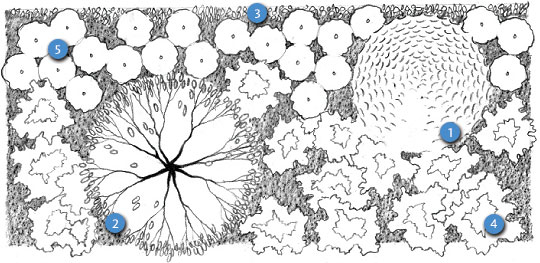A Cool Garden in the Shade
Intrepid urban gardeners are accustomed to adjusting their plant palette to lower light conditions as a consequence of the ubiquitous tall buildings and unchecked weed trees of the cityscape. The popular notion that shade is a gardening handicap because it severely restricts plant choices is a myth: There are numerous and diverse species that flourish in shady sites. Conjure the wealth of wildflowers growing on the woodland floor, including species of Polygonatum (Solomon’s seal), Tiarella (foamflower), Trillium, and Aruncus (goat’s beard), and add to these the many cultivated and hybridized varieties of Anemone, Astilbe, Brunnera, Cimicifuga, Dicentra, and Epimedium (a quick memory jog: “ABCDE for shade”), and you have a panoply of plants that can be combined for their valuable distinctive foliage and sequential blooms to illuminate any shady corner.
A distinction should be made between plants that tolerate shade but otherwise thrive in the sun and vice-versa. Among sun lovers that can take some shade is Fothergilla gardenii (dwarf witch alder) with its fragrant bottlebrush flowers in spring and fine coppery foliage in fall. A good example of “vice-versa” is Hydrangea, a classic staple of the shrub border. Most species generally do well in partial shade; they flower best given bright morning light.
The process of choosing plants for shade often begins with the tried and true—ferns, hostas, and yews. Some people’s enthusiasm may be dampened for fear of repeating the very familiar, but there’s good reason for these plants’ ubiquity. They work. They can be seen surviving in some of the most difficult sites around the city and may be used to great practical and aesthetic advantage. In particular, Taxus x media ‘Hicksii’ (‘Hicksii’ yew) provides a rich deep green year-round screen or vertical accent and may be underplanted with the striking foliage combination of wide-spreading Hosta fortunei ‘June’ and upright, feathery Athyrium niponicum var. pictum ‘Burgundy Lace’ (Japanese painted fern) for a winning trio. If you’re sitting under a tree and feeling in the dark, try covering the ground with a tactile combination of Asarum europaeum (European ginger) with its glossy evergreen leaves elevated just a few inches above a velvety cushion of moss, both of which will endure dry periods once they’ve been established with ample moisture..

Ilex x aquipernyi ‘Meschick’ DRAGON LADY (holly cultivar)
15 feet tall; 4 feet wide
This columnar evergreen shrub has dense, deep green, glossy foliage that welcomes pruning; abundant red berries form on this female cultivar when pollinated by male I. x meservae holly. Prefers well-drained, ordinary soil, even sand. Zones 6 to 8.Enkianthus campanulatus (redvein enkianthus)
8 feet tall; 10 feet wide
This deciduous shrub blooms with clusters of lovely pendulous, bell-shaped cream-colored flowers with red veins in May through June. Prefers well-drained, acidic soil. Zones 4 to 7.Kerria japonica ‘Picta’ (Japanese kerria)
5 feet tall; 3 feet wide
Pale green stems hold attractive double-serrate, variegated leaves edged in white with single yellow flowers in spring through summer. May be trained on a fence, as in illustration. Zones 4 to 9.Astilbe chinensis ‘Pumila’ (astilbe cultivar)
15 inches tall and wide
Distinctive dwarf with spreading foliage makes a fine groundcover; rosy-lilac bottle-brush-shaped flowers bloom in midsummer. Prefers moist soil. Zones 3 to 8.Liriope spicata ‘Silver Dragon’ (variegated lilyturf cultivar)
9 inches tall and widee
Slender green leaves edged with silvery white provide a lush, clumping evergreen groundcover; spikes of lavender flowers rise on long stems in August through September. Zones 6 to 9.


